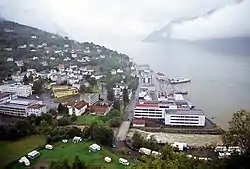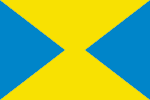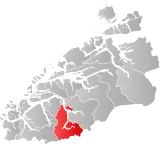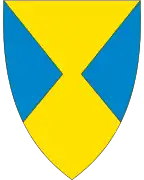Stranda Municipality
Stranda kommune | |
|---|---|
| Stranden herred (historic name) | |
 View of the village of Stranda | |
 Flag | |
 Møre og Romsdal within Norway | |
 Stranda within Møre og Romsdal | |
| Coordinates: 62°11′29″N 06°56′56″E / 62.19139°N 6.94889°E | |
| Country | Norway |
| County | Møre og Romsdal |
| District | Sunnmøre |
| Established | 1 Jan 1838 |
| • Created as | Formannskapsdistrikt |
| Administrative centre | Stranda |
| Government | |
| • Mayor (2011) | Jan Ove Tryggestad (Sp) |
| Area | |
| • Total | 865.87 km2 (334.31 sq mi) |
| • Land | 844.64 km2 (326.12 sq mi) |
| • Water | 21.23 km2 (8.20 sq mi) 2.5% |
| • Rank | #134 in Norway |
| Population (2022) | |
| • Total | 4,467 |
| • Rank | #192 in Norway |
| • Density | 5.3/km2 (14/sq mi) |
| • Change (10 years) | |
| Demonym(s) | Strandar Strander[1] |
| Official language | |
| • Norwegian form | Nynorsk |
| Time zone | UTC+01:00 (CET) |
| • Summer (DST) | UTC+02:00 (CEST) |
| ISO 3166 code | NO-1525[3] |
| Website | Official website |
Stranda is a municipality in Møre og Romsdal county, Norway. It is part of the Sunnmøre region. The administrative centre of the municipality is the village of Stranda. Stranda consists of three smaller villages and one larger central village. The smaller villages are Hellesylt, Geiranger, and Liabygda. The central village, Stranda (same name as the municipality), has about 2,600 inhabitants. Stranda Municipality is known for tourist attractions like the Geirangerfjorden Sunnylvsfjorden and its skiarea at Strandafjellet
The 866-square-kilometre (334 sq mi) municipality is the 134th largest by area out of the 356 municipalities in Norway. Stranda is the 192nd most populous municipality in Norway with a population of 4,467. The municipality's population density is 5.3 inhabitants per square kilometre (14/sq mi) and its population has decreased by 2.9% over the previous 10-year period.[4][5]
General information
The parish of Stranden was established as a municipality on 1 January 1838 (see formannskapsdistrikt law). On 1 January 1892, the northern district of the municipality (population: 850) was separated to form the new Stordal Municipality. This left Stranda with 1,459 residents. The spelling was changed to Stranda in 1918. During the 1960s, there were many municipal mergers across Norway due to the work of the Schei Committee. On 1 January 1965, Sunnylven Municipality (population: 1,221) was merged into Stranda, forming a new, larger Stranda Municipality.[6]
Name
The municipality (originally the parish) is named Stranda (Old Norse: Strǫnd) after a portion of the beach area along the Storfjorden. The name comes from the word strǫnd which means "beach" or "strand".[7] Historically, the name of the municipality was spelled Stranden. On 3 November 1917, a royal resolution changed the spelling of the name of the municipality to Stranda.[8]
Coat of arms
The coat of arms was granted on 2 May 1986. The official blazon is "Or, two piles azure issuant from dexter and sinister" (Norwegian: På gull grunn to spisse blå flankar). This means the arms have a field (background) has a tincture of Or which means it is commonly colored yellow, but if it is made out of metal, then gold is used. The charge is two blue piles (triangles) extending from the left and right sides, but not quite meeting in the middle. The colors and design were chosen to symbolize the fjords and mountains hovering over the beach since the fjord is a central feature of the municipality for transportation, production, and tourism. The arms were designed by Jarle Skuseth after a proposal by Tor Torheim. The municipal flag has the same design as the coat of arms.[9][10][11]
Churches
The Church of Norway has four parishes (sokn) within the municipality of Stranda. It is part of the Austre Sunnmøre prosti (deanery) in the Diocese of Møre.
| Parish (sokn) | Church name | Location of the church | Year built |
|---|---|---|---|
| Stranda | Stranda Church | Stranda | 1838 |
| Liabygda | Liabygda Church | Liabygda | 1917 |
| Sunnylven | Sunnylven Church | Hellesylt | 1859 |
| Geiranger | Geiranger Church | Geiranger | 1842 |
Geography

The West Norwegian Fjords, entailing Geirangerfjord and Nærøyfjord was inscribed on UNESCO's World Heritage List in 2005 at the 29th Session of the World Heritage Committee in Durban, South Africa. The West Norwegian Fjords is the first natural World Heritage site in Norway, and the third natural site in the Nordic – Baltic region.
The West Norwegian Fjords are characterised as the best geologically developed and preserved example of classic fjord landscape. The geology and ongoing erosional processes have provided a basis for the active development of ecological and biological processes as well as the development of traditional, in part extreme, land use that has not harmed the integrity of the natural site.
Due to its natural environment, this scenic area is one of the most visited in the Nordic countries. The area has examples of landforms shaped and developed by ice and water, a landscape with significant geomorphological features, and a very young landscape in terms of Earth history that is continuously being formed by active erosional processes. The area represents the most extreme and dramatic fjord landscape in the world and has an exceptional aesthetic importance.
The Seven Sisters waterfall is located along the Geirangerfjord. The mountain Dalsnibba and the lake Djupvatnet are located along Norwegian County Road 63 in the southern part of the municipality. The mountains of Kvitegga and Hornindalsrokken lie on the southern municipal border.
Government
All municipalities in Norway are responsible for primary education (through 10th grade), outpatient health services, senior citizen services, welfare and other social services, zoning, economic development, and municipal roads and utilities. The municipality is governed by a municipal council of directly elected representatives. The mayor is indirectly elected by a vote of the municipal council.[12] The municipality falls under the Møre og Romsdal District Court and the Frostating Court of Appeal.
Municipal council
The municipal council (Kommunestyre) of Stranda is made up of 25 representatives that are elected to four year terms. The party breakdown of the council is as follows:
| Party name (in Nynorsk) | Number of representatives | |
|---|---|---|
| Labour Party (Arbeidarpartiet) | 3 | |
| Progress Party (Framstegspartiet) | 5 | |
| Green Party (Miljøpartiet Dei Grøne) | 1 | |
| Conservative Party (Høgre) | 3 | |
| Christian Democratic Party (Kristeleg Folkeparti) | 1 | |
| Centre Party (Senterpartiet) | 12 | |
| Total number of members: | 25 | |
| Party name (in Nynorsk) | Number of representatives | |
|---|---|---|
| Labour Party (Arbeidarpartiet) | 3 | |
| Progress Party (Framstegspartiet) | 5 | |
| Conservative Party (Høgre) | 3 | |
| Christian Democratic Party (Kristeleg Folkeparti) | 2 | |
| Centre Party (Senterpartiet) | 11 | |
| Liberal Party (Venstre) | 1 | |
| Total number of members: | 25 | |
| Party name (in Nynorsk) | Number of representatives | |
|---|---|---|
| Labour Party (Arbeidarpartiet) | 3 | |
| Progress Party (Framstegspartiet) | 8 | |
| Conservative Party (Høgre) | 3 | |
| Christian Democratic Party (Kristeleg Folkeparti) | 2 | |
| Centre Party (Senterpartiet) | 8 | |
| Liberal Party (Venstre) | 1 | |
| Total number of members: | 25 | |
| Party name (in Nynorsk) | Number of representatives | |
|---|---|---|
| Labour Party (Arbeidarpartiet) | 2 | |
| Progress Party (Framstegspartiet) | 12 | |
| Conservative Party (Høgre) | 2 | |
| Christian Democratic Party (Kristeleg Folkeparti) | 2 | |
| Centre Party (Senterpartiet) | 4 | |
| Socialist Left Party (Sosialistisk Venstreparti) | 1 | |
| Liberal Party (Venstre) | 2 | |
| Total number of members: | 25 | |
| Party name (in Nynorsk) | Number of representatives | |
|---|---|---|
| Labour Party (Arbeidarpartiet) | 3 | |
| Progress Party (Framstegspartiet) | 9 | |
| Conservative Party (Høgre) | 3 | |
| Christian Democratic Party (Kristeleg Folkeparti) | 3 | |
| Centre Party (Senterpartiet) | 3 | |
| Socialist Left Party (Sosialistisk Venstreparti) | 2 | |
| Total number of members: | 23 | |
| Party name (in Nynorsk) | Number of representatives | |
|---|---|---|
| Labour Party (Arbeidarpartiet) | 4 | |
| Progress Party (Framstegspartiet) | 5 | |
| Conservative Party (Høgre) | 5 | |
| Christian Democratic Party (Kristeleg Folkeparti) | 4 | |
| Centre Party (Senterpartiet) | 5 | |
| Liberal Party (Venstre) | 2 | |
| Total number of members: | 25 | |
| Party name (in Nynorsk) | Number of representatives | |
|---|---|---|
| Labour Party (Arbeidarpartiet) | 5 | |
| Conservative Party (Høgre) | 5 | |
| Christian Democratic Party (Kristeleg Folkeparti) | 8 | |
| Centre Party (Senterpartiet) | 8 | |
| Liberal Party (Venstre) | 3 | |
| Total number of members: | 29 | |
| Party name (in Nynorsk) | Number of representatives | |
|---|---|---|
| Labour Party (Arbeidarpartiet) | 5 | |
| Progress Party (Framstegspartiet) | 1 | |
| Conservative Party (Høgre) | 7 | |
| Christian Democratic Party (Kristeleg Folkeparti) | 5 | |
| Centre Party (Senterpartiet) | 5 | |
| Liberal Party (Venstre) | 1 | |
| Local list for Sunnylven (Bygdeliste for Sunnylven) | 5 | |
| Total number of members: | 29 | |
| Party name (in Nynorsk) | Number of representatives | |
|---|---|---|
| Labour Party (Arbeidarpartiet) | 6 | |
| Conservative Party (Høgre) | 7 | |
| Christian Democratic Party (Kristeleg Folkeparti) | 5 | |
| Centre Party (Senterpartiet) | 3 | |
| Liberal Party (Venstre) | 3 | |
| Local list for Sunnylven (Bygdeliste for Sunnylven) | 5 | |
| Total number of members: | 29 | |
| Party name (in Nynorsk) | Number of representatives | |
|---|---|---|
| Labour Party (Arbeidarpartiet) | 8 | |
| Conservative Party (Høgre) | 6 | |
| Christian Democratic Party (Kristeleg Folkeparti) | 5 | |
| Centre Party (Senterpartiet) | 3 | |
| Liberal Party (Venstre) | 3 | |
| Local list for Sunnylven (Bygdeliste for Sunnylven) | 4 | |
| Total number of members: | 29 | |
| Party name (in Nynorsk) | Number of representatives | |
|---|---|---|
| Labour Party (Arbeidarpartiet) | 6 | |
| Conservative Party (Høgre) | 5 | |
| Christian Democratic Party (Kristeleg Folkeparti) | 6 | |
| Liberal People's Party (Liberale Folkepartiet) | 1 | |
| Centre Party (Senterpartiet) | 4 | |
| Liberal Party (Venstre) | 2 | |
| Local list for Sunnylven (Bygdaliste for Sunnylven) | 4 | |
| Local list for Geiranger (Bygdeliste for Geiranger) | 1 | |
| Total number of members: | 29 | |
| Party name (in Nynorsk) | Number of representatives | |
|---|---|---|
| Labour Party (Arbeidarpartiet) | 6 | |
| Conservative Party (Høgre) | 2 | |
| Christian Democratic Party (Kristeleg Folkeparti) | 6 | |
| New People's Party (Nye Folkepartiet) | 2 | |
| Centre Party (Senterpartiet) | 5 | |
| Liberal Party (Venstre) | 2 | |
| Local list for Sunnylven (Bygdaliste for Sunnylven) | 5 | |
| Local list for Geiranger (Bygdeliste for Geiranger) | 1 | |
| Total number of members: | 29 | |
| Party name (in Nynorsk) | Number of representatives | |
|---|---|---|
| Labour Party (Arbeidarpartiet) | 8 | |
| Conservative Party (Høgre) | 2 | |
| Christian Democratic Party (Kristeleg Folkeparti) | 5 | |
| Centre Party (Senterpartiet) | 10 | |
| Liberal Party (Venstre) | 4 | |
| Total number of members: | 29 | |
| Party name (in Nynorsk) | Number of representatives | |
|---|---|---|
| Labour Party (Arbeidarpartiet) | 8 | |
| Conservative Party (Høgre) | 2 | |
| Christian Democratic Party (Kristeleg Folkeparti) | 5 | |
| Centre Party (Senterpartiet) | 9 | |
| Liberal Party (Venstre) | 5 | |
| Total number of members: | 29 | |
| Party name (in Nynorsk) | Number of representatives | |
|---|---|---|
| Labour Party (Arbeidarpartiet) | 6 | |
| Conservative Party (Høgre) | 2 | |
| Christian Democratic Party (Kristeleg Folkeparti) | 5 | |
| Centre Party (Senterpartiet) | 5 | |
| Liberal Party (Venstre) | 3 | |
| Total number of members: | 21 | |
| Party name (in Nynorsk) | Number of representatives | |
|---|---|---|
| Labour Party (Arbeidarpartiet) | 6 | |
| Conservative Party (Høgre) | 1 | |
| Christian Democratic Party (Kristeleg Folkeparti) | 6 | |
| Centre Party (Senterpartiet) | 4 | |
| Liberal Party (Venstre) | 3 | |
| Local List(s) (Lokale lister) | 1 | |
| Total number of members: | 21 | |
| Party name (in Nynorsk) | Number of representatives | |
|---|---|---|
| Labour Party (Arbeidarpartiet) | 5 | |
| Local List(s) (Lokale lister) | 16 | |
| Total number of members: | 21 | |
| Party name (in Nynorsk) | Number of representatives | |
|---|---|---|
| Labour Party (Arbeidarpartiet) | 2 | |
| Local List(s) (Lokale lister) | 14 | |
| Total number of members: | 16 | |
| Party name (in Nynorsk) | Number of representatives | |
|---|---|---|
| Labour Party (Arbeidarpartiet) | 2 | |
| Local List(s) (Lokale lister) | 14 | |
| Total number of members: | 16 | |
| Party name (in Nynorsk) | Number of representatives | |
|---|---|---|
| Labour Party (Arbeidarpartiet) | 2 | |
| Local List(s) (Lokale lister) | 14 | |
| Total number of members: | 16 | |
| Party name (in Nynorsk) | Number of representatives | |
|---|---|---|
| Labour Party (Arbeidarpartiet) | 1 | |
| Local List(s) (Lokale lister) | 15 | |
| Total number of members: | 16 | |
| Note: Due to the German occupation of Norway during World War II, no elections were held for new municipal councils until after the war ended in 1945. | ||
Mayors
The mayors of Stranda:
- 1838–1840: Nicolay Hansen Engeset
- 1841–1855: Severin Knutsen Overvoll
- 1856–1883: Knut Olson Myklebust
- 1884–1885: Lars Martinussen Kirkebøe
- 1886–1889: Hans J. Ringstad
- 1890–1901: Peter C. Ous
- 1902–1904: Hans J. Ringstad
- 1905–1913: Peter C. Ous
- 1914–1931: Karl J. Andeberg
- 1931–1937: Claus P. Ous
- 1938–1943: Nils E. Ringset
- 1945–1945: Nils E. Ringset
- 1946–1955: Jørgen Marius Ivarsen Langlo (KrF)
- 1956–1957: Einar Holmgren
- 1957–1959: Ole S. Helsem (Bp)
- 1960–1963: Ingvald Langlo
- 1964–1965: Reidar Skarbø
- 1966–1967: Ole S. Helsem (Sp)
- 1968–1971: Rikard Urkedal
- 1972–1975: Leiv Berge
- 1976–1979: Oddmund Indreeide
- 1980–1987: Leiv Berge
- 1988–1991: Inge Gjærde
- 1992–1999: Anne Lise Lunde (KrF)
- 1999–2003: Inge Gjærde (H)
- 2003–2011: Frank Edvard Sve (FrP)
- 2011–present: Jan Ove Tryggestad (Sp)
Tourism

Tourism has long and strong traditions in Stranda. The villages of Geiranger and Hellesylt have long been well-known destinations. The first cruise ship with tourists from abroad came to Geiranger in 1869. Today, Geiranger is the second largest cruise ship port in Norway, visited by 160 cruise ships every summer. The Coastal Steamer (Hurtigruten) runs daily round trips Ålesund-Geiranger from April to mid-September. Altogether about 700,000 tourists visit Geiranger each summer.
Royal persons, especially Queen Sonja, have contributed to make the fjord famous all over the world. By annual trips, visiting, and even spending the night on these abandoned mountains farms such as Skageflå, and publishing a book about these trips with her own photos that have also been exhibited in New York, among other places. Other historic farms include Knivsflå and Me-Åkernes.
Sports and leisure
In the alpine area at Strandafjellet, there are six Ski tows and alpine pistes. Each winter alpine competitions are hosted there. Strandafjellet is one of the few places in the world where one could actually ski from the top of a mountain and go the whole way down, to the fjord. Every year roughly 250 telemark skiers, alpineskiers and snowboarders come together in the race Alperittet, from 1,230 metres (4,040 ft) above sea level and down to the fjord. The Geiranger – From Fjord to Summit race runs from Geiranger to Dalsnibba each year.
Culture
In Hellesylt, one may visit Hægstad Gård which contains woodcarvings, scenes from Peer Gynt by Henrik Ibsen, and in Geiranger the new Norwegian Fjord Centre shows local history and pictures from Geiranger.
Trade and industry
The municipality of Stranda has a great variety as to trade and industry. About 160 farms produce milk and meat products. Many factories have long traditions for making meat products, especially salted and cured meat. Also the making of furniture and textile products is an important industry that gives good work to many persons. Stranda is the place where P.I. Langlo industrialized the furniture industry in Norway in 1919.[31] (There is almost no unemployment in the area). The Grandiosa factory, Norway's biggest pizza-producing factory is situated in Stranda. There are also much aquafarming and many fish processing factories in the municipality. Tourism is, of course, a very important business in the whole district.
In popular culture
- Released in March 2016, "The Wave (Bølgen)" is a Norwegian disaster movie based on the premise of a rock slide from the mountain Åkerneset inundating the town of Geiranger.[32]
Notable people

.jpg.webp)
- Olaf Skavlan (1838–1891) a Norwegian literary historian and playwright
- Aadel Lampe (1857-1944) a Norwegian women's rights leader, liberal politician, teacher for deaf children and suffragist
- Olav Berntsen Oksvik (1887–1958) politician and County Governor of Møre og Romsdal
- P.I. Langlo, (Norwegian Wiki) (1892–1940), pioneered the industrial manufacture of furniture
- Eiliv Odde Hauge (1913–1971) a military officer, screenwriter, author, museum director and Norwegian resistance movement member
- Asbjørn Gjærde (born 1939) journalist, worked for NRK for 43 years
- Peter Opsvik (born 1939) furniture designer and jazz saxophonist
- Kjell A. Storeide (born 1952) a Norwegian businessperson, CEO of Stokke Gruppen 1990–2004
- Pål Øie, (Norwegian Wiki) (born 1961) a Norwegian film director [33]
- Arve Henriksen (born 1968) a Norwegian trumpeter
- Are Kalvø (born 1969) a Norwegian writer and satirist
- Margreth Olin (born 1970) a Norwegian film director, film producer and screenwriter [34]
- Bjarne Solbakken (born 1977) alpine skier, competed in the 2002 and 2006 Winter Olympics
- Øyvind Skarbø (born 1982) a Norwegian drummer and composer
See also
- Norwegian Colony, a Norwegian community in California established by families from Stranda.
References
- ↑ "Navn på steder og personer: Innbyggjarnamn" (in Norwegian). Språkrådet.
- ↑ "Forskrift om målvedtak i kommunar og fylkeskommunar" (in Norwegian). Lovdata.no.
- ↑ Bolstad, Erik; Thorsnæs, Geir, eds. (26 January 2023). "Kommunenummer". Store norske leksikon (in Norwegian). Kunnskapsforlaget.
- ↑ Statistisk sentralbyrå. "Table: 06913: Population 1 January and population changes during the calendar year (M)" (in Norwegian).
- ↑ Statistisk sentralbyrå. "09280: Area of land and fresh water (km²) (M)" (in Norwegian).
- ↑ Jukvam, Dag (1999). Historisk oversikt over endringer i kommune- og fylkesinndelingen (PDF) (in Norwegian). Statistisk sentralbyrå. ISBN 9788253746845.
- ↑ Rygh, Oluf (1908). Norske gaardnavne: Romsdals amt (in Norwegian) (13 ed.). Kristiania, Norge: W. C. Fabritius & sønners bogtrikkeri. p. 126.
- ↑ "Norsk Lovtidende. 2den Afdeling. 1917. Samling af Love, Resolutioner m.m". Norsk Lovtidend (in Norwegian). Kristiania, Norge: Grøndahl og Søns Boktrykkeri: 1057–1065. 1917.
- ↑ "Civic heraldry of Norway - Norske Kommunevåpen". Heraldry of the World. Retrieved 15 April 2023.
- ↑ "Stranda, Møre og Romsdal (Norway)". Flags of the World. Retrieved 15 April 2023.
- ↑ "Godkjenning av våpen og flagg". Lovdata.no (in Norwegian). Norges kommunal- og arbeidsdepartementet. 9 May 1986. Retrieved 15 April 2023.
- ↑ Hansen, Tore; Vabo, Signy Irene, eds. (20 September 2022). "kommunestyre". Store norske leksikon (in Norwegian). Kunnskapsforlaget. Retrieved 14 October 2022.
- ↑ "Tall for Norge: Kommunestyrevalg 2019 - Møre og Romsdal" (in Norwegian). Statistics Norway. Retrieved 19 October 2019.
- 1 2 3 4 "Table: 04813: Members of the local councils, by party/electoral list at the Municipal Council election (M)" (in Norwegian). Statistics Norway.
- ↑ "Tall for Norge: Kommunestyrevalg 2011 - Møre og Romsdal" (in Norwegian). Statistics Norway. Retrieved 19 October 2019.
- ↑ "Kommunestyrevalget 1995" (PDF) (in Norwegian). Oslo-Kongsvinger: Statistisk sentralbyrå. 1996. Retrieved 1 May 2020.
- ↑ "Kommunestyrevalget 1991" (PDF) (in Norwegian). Oslo-Kongsvinger: Statistisk sentralbyrå. 1993. Retrieved 1 May 2020.
- ↑ "Kommunestyrevalget 1987" (PDF) (in Norwegian). Oslo-Kongsvinger: Statistisk sentralbyrå. 1988. Retrieved 1 May 2020.
- ↑ "Kommunestyrevalget 1983" (PDF) (in Norwegian). Oslo-Kongsvinger: Statistisk sentralbyrå. 1984. Retrieved 1 May 2020.
- ↑ "Kommunestyrevalget 1979" (PDF) (in Norwegian). Oslo: Statistisk sentralbyrå. 1979. Retrieved 1 May 2020.
- ↑ "Kommunevalgene 1975" (PDF) (in Norwegian). Oslo: Statistisk sentralbyrå. 1977. Retrieved 1 May 2020.
- ↑ "Kommunevalgene 1972" (PDF) (in Norwegian). Oslo: Statistisk sentralbyrå. 1973. Retrieved 1 May 2020.
- ↑ "Kommunevalgene 1967" (PDF) (in Norwegian). Oslo: Statistisk sentralbyrå. 1967. Retrieved 1 May 2020.
- ↑ "Kommunevalgene 1963" (PDF) (in Norwegian). Oslo: Statistisk sentralbyrå. 1964. Retrieved 1 May 2020.
- ↑ "Kommunevalgene og Ordførervalgene 1959" (PDF) (in Norwegian). Oslo: Statistisk sentralbyrå. 1960. Retrieved 1 May 2020.
- ↑ "Kommunevalgene og Ordførervalgene 1955" (PDF) (in Norwegian). Oslo: Statistisk sentralbyrå. 1957. Retrieved 1 May 2020.
- ↑ "Kommunevalgene og Ordførervalgene 1951" (PDF) (in Norwegian). Oslo: Statistisk sentralbyrå. 1952. Retrieved 1 May 2020.
- ↑ "Kommunevalgene og Ordførervalgene 1947" (PDF) (in Norwegian). Oslo: Statistisk sentralbyrå. 1948. Retrieved 1 May 2020.
- ↑ "Kommunevalgene og Ordførervalgene 1945" (PDF) (in Norwegian). Oslo: Statistisk sentralbyrå. 1947. Retrieved 1 May 2020.
- ↑ "Kommunevalgene og Ordførervalgene 1937" (PDF) (in Norwegian). Oslo: Statistisk sentralbyrå. 1938. Retrieved 1 May 2020.
- ↑ Gjærde, Asbjørn (1990). Stranda, Industri og samfunn (in Norwegian). Ålesund, Norge: Stranda Sogelag. p. 64.
- ↑ "The Wave (2015) Bølgen (original title)". IMDb. Retrieved 16 March 2016.
- ↑ IMDb Database retrieved 24 November 2020
- ↑ IMDb Database retrieved 24 November 2020
External links
- Municipal fact sheet from Statistics Norway (in Norwegian)
- West Norwegian Fjords UNESCO World Heritage Site (in Norwegian)
- Storfjordens Venner (in Norwegian)
- Strandafjellet downhill skiing
- Visit Geiranger
- Norwegian Fjord Centre
- Destinasjon Geirangerfjord – Trollstigen
- Local information and news (in Norwegian)
- Sunnmøringen local newspaper (in Norwegian)
- Map

